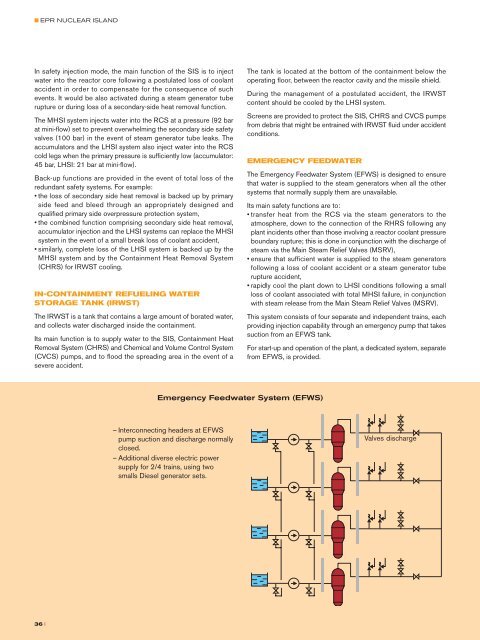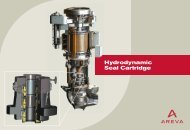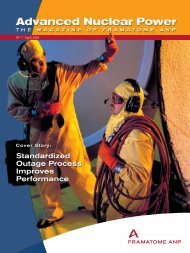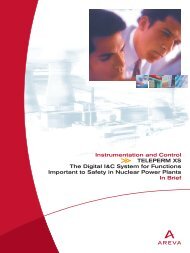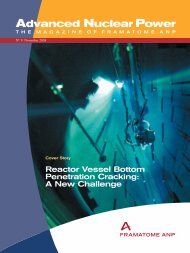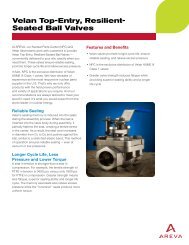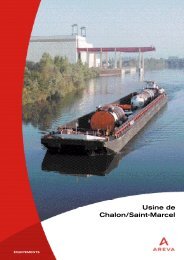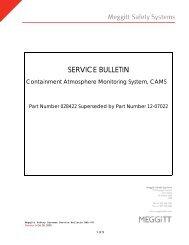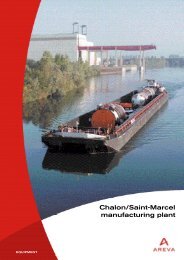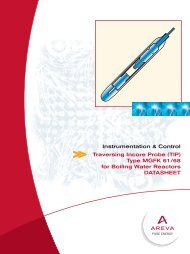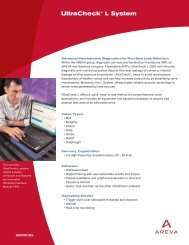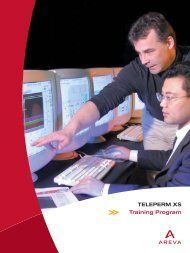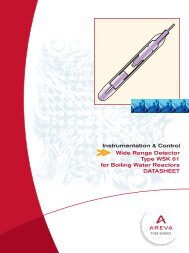EPR – Areva brochure
EPR – Areva brochure
EPR – Areva brochure
Create successful ePaper yourself
Turn your PDF publications into a flip-book with our unique Google optimized e-Paper software.
■ <strong>EPR</strong> NUCLEAR ISLANDIn safety injection mode, the main function of the SIS is to injectwater into the reactor core following a postulated loss of coolantaccident in order to compensate for the consequence of suchevents. It would be also activated during a steam generator tuberupture or during loss of a secondary-side heat removal function.The MHSI system injects water into the RCS at a pressure (92 barat mini-flow) set to prevent overwhelming the secondary side safetyvalves (100 bar) in the event of steam generator tube leaks. Theaccumulators and the LHSI system also inject water into the RCScold legs when the primary pressure is sufficiently low (accumulator:45 bar, LHSI: 21 bar at mini-flow).Back-up functions are provided in the event of total loss of theredundant safety systems. For example:• the loss of secondary side heat removal is backed up by primaryside feed and bleed through an appropriately designed andqualified primary side overpressure protection system,• the combined function comprising secondary side heat removal,accumulator injection and the LHSI systems can replace the MHSIsystem in the event of a small break loss of coolant accident,• similarly, complete loss of the LHSI system is backed up by theMHSI system and by the Containment Heat Removal System(CHRS) for IRWST cooling.IN-CONTAINMENT REFUELING WATERSTORAGE TANK (IRWST)The IRWST is a tank that contains a large amount of borated water,and collects water discharged inside the containment.Its main function is to supply water to the SIS, Containment HeatRemoval System (CHRS) and Chemical and Volume Control System(CVCS) pumps, and to flood the spreading area in the event of asevere accident.The tank is located at the bottom of the containment below theoperating floor, between the reactor cavity and the missile shield.During the management of a postulated accident, the IRWSTcontent should be cooled by the LHSI system.Screens are provided to protect the SIS, CHRS and CVCS pumpsfrom debris that might be entrained with IRWST fluid under accidentconditions.EMERGENCY FEEDWATERThe Emergency Feedwater System (EFWS) is designed to ensurethat water is supplied to the steam generators when all the othersystems that normally supply them are unavailable.Its main safety functions are to:• transfer heat from the RCS via the steam generators to theatmosphere, down to the connection of the RHRS following anyplant incidents other than those involving a reactor coolant pressureboundary rupture; this is done in conjunction with the discharge ofsteam via the Main Steam Relief Valves (MSRV),• ensure that sufficient water is supplied to the steam generatorsfollowing a loss of coolant accident or a steam generator tuberupture accident,• rapidly cool the plant down to LHSI conditions following a smallloss of coolant associated with total MHSI failure, in conjunctionwith steam release from the Main Steam Relief Valves (MSRV).This system consists of four separate and independent trains, eachproviding injection capability through an emergency pump that takessuction from an EFWS tank.For start-up and operation of the plant, a dedicated system, separatefrom EFWS, is provided.OTHER SAFETY SYSTEMSThe Extra Borating System (EBS) ensures sufficient boration ofthe RCS for transfer to the safe shutdown state with the Boronconcentration required for cold shutdown. This system consists oftwo separate and independent trains, each capable of injecting thetotal amount of concentrated boric acid required to reach the coldshutdown condition from any steady state power operation.Outside the containment, part of the Main Steam System (MSS)is safety classified. This part consists of four geographicallyseparated but identical trains. Each includes one main steam isolationvalve, one main steam relief valve, one main steam relief isolationvalve and two spring-loaded main steam safety valves.Outside the containment, part of the Main Feedwater System (MFS)is safety classified. It consists of four geographically separated butidentical trains. Each includes main feedwater isolation and control valves.In addition to the safety systems described above, other safetyfunctions are performed to mitigate postulated severe accidents,as described in the section dealing with safety and severe accidents.COMPONENT COOLING WATERThe Component Cooling Water System (CCWS) transfers heat fromthe safety related systems, operational auxiliary systems and otherreactor equipment to the heat sink via the Essential Service WaterSystem (ESWS) under all normal operating conditions.The CCWS also performs the following safety functions:• removes heat from the SIS/RHRS to the ESWS,•removes heat from the Fuel Pool Cooling System (FPCS) to theESWS for as long as any fuel assemblies are located in the spentfuel storage pool outside the containment,• cools the thermal barriers of the Reactor Coolant Pump (RCP)seals,• removes heat from the chillers in divisions 2 and 3 and cools theContainment Heat Removal System (CHRS) by means of twoseparate trains.The CCWS consists of four separate safety trains correspondingto the four divisions of the safeguard buildings.ESSENTIAL SERVICE WATERThe Essential Service Water System (ESWS) consists of fourseparate safety trains which cool the CCWS heat exchangers withwater from the heat sink during all normal plant operating conditionsand during incidents and accidents. This system also includes twotrains of the dedicated cooling chain for conditions associated withthe mitigation of postulated severe accidents.OTHER SYSTEMSOther systems include the Nuclear Sampling, Nuclear Island Ventand Drain, Steam Generator Blowdown, and Waste TreatmentSystems.•TheNuclear Sampling System is used for taking samples of gasesand liquid from systems and equipment located inside the reactorcontainment.•The Vent and Drain System collects gaseous and liquid wastefrom systems and equipment so that it can be treated.•TheSteam Generator Blowdown System prevents the build-upof solid matter in the secondary side water.•The Waste Treatment System ensures the treatment of solid,gaseous and liquid wastes.Emergency Feedwater System (EFWS)<strong>–</strong>Interconnecting headers at EFWSpump suction and discharge normallyclosed.<strong>–</strong> Additional diverse electric powersupply for 2/4 trains, using twosmalls Diesel generator sets.Valves dischargeSAFETY SYSTEMS AND FUNCTIONS† Simplification by separation of operatingand safety functions.† Fourfold redundancy applied to thesafeguard systems and to their supportsystems. This architecture allows theirmaintenance during plant operation,thus ensuring a high plant availabilityfactor.† The different trains of the safety systemsare located in four different buildings inwhich strict physical separation is applied.† With systematic functional diversity, thereis always a diversified system which canperform the desired function and bring theplant back to a safe condition in the highlyunlikely event of a redundant systembecoming totally unavailable.36 II 37


